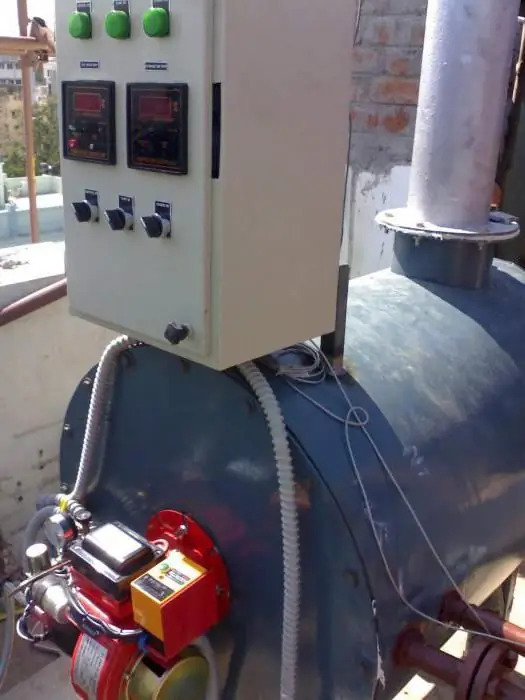2025 Author: Howard Calhoun | [email protected]. Last modified: 2025-01-24 13:10:34
Glancing at any modern city from a bird's eye view, one can be surprised at the richness of its infrastructure. Almost wall to wall with residential buildings, buildings of various institutions, territories of industrial enterprises, high-rise business centers, department stores and other objects can be located. Not to mention the numerous bridges and various towers. Indeed, the building density of modern cities is amazing. All this complicates the construction and repair work. The more landscaped the territory, the more difficult it is to use special equipment.

This is what climbing works are for, which are often carried out by people with extreme training - climbers, rock climbers, speleologists who decide to make their dangerous hobby their main speci alty. They replace bulky mechanisms with a reliable rope, mounting belt andvirtuoso technique of working on the sheer wall of the "stone jungle".
Although now more and more training centers for industrial climbers are opening every day, climbing work is still in most cases performed by athletes who have repeatedly climbed the highest mountain peaks or descended into the abysses of the deepest caves. Of course, they all receive special construction skills for working at height beforehand.

Work at height, in other words, climbing work - these are various operations performed at a level of at least five meters above the ground, ceiling or working platform. That is, these are working conditions where a person and his insurance are left alone with the space that extends below. Dangerous job! Therefore, labor protection when working at height puts forward special safety requirements. The main means of fall protection, according to the rules for working at height, are a safety belt and a safety rope. To protect the head, a special helmet is provided, which must first be checked and for which a quality certificate must be available.

High climbing has an interesting history. So, back in the harsh blockade times, a group of Leningrad climbers (now they would be called industrial climbers) performed the most difficult task of masking the golden domes of cathedrals, which made it impossible for Luftwaffe pilots to conduct targeted bombing of St. Petersburg churches. Now one can only guess what the cultural and spiritual capital of Russia would look like today, if it were not for the selfless and heroic work of the first domestic industrial climbers.
It is also interesting that high- altitude work was officially legalized in Russia in 2001, when this profession was entered into the relevant register and thus legalized. Although such a complex and dangerous speci alty, of course, existed long before its official recognition.
Today, the services of industrial climbers are extremely in demand for installation, facade, restoration, and cleaning work. And also when lifting bulky goods in hard-to-reach places. Often only a professional industrial climber, who has psychological training to work in an unsupported space and special skills, can install an advertising banner, clean the roof of a high-rise building from ice and snow, or wash the windows of a skyscraper.
Recommended:
Work at Magnit Cosmetic: employee reviews, working conditions, job responsibilities and features of the work performed

Prospect of career growth is one of the tempting promises of employers. According to the feedback from employees about working at Magnit Cosmetic, here you can really reach certain heights in just a couple of years, starting as a sales assistant and becoming the director of one of the chain stores. Is it true or not? Let's try to find the answer to this and many other questions
Window cleaning is one of the industrial mountaineering services

There are situations when there is a catastrophic lack of time to clean the apartment due to a difficult work schedule, and sometimes just strength. What can we say about window cleaning? But not only the perception of the entire interior, but also the mood depends on their purity. Yes, it's the mood. Therefore, if there is no opportunity to bring comfort to your home by organizing window cleaning, it is better to use the help of professionals
Work permit for work in electrical installations. Rules for work in electrical installations. Work permit

From August 2014, Law No. 328n comes into force. In accordance with it, a new edition of the "Rules on labor protection during the operation of electrical installations" is being introduced
Industrial boilers: description, types, functions. Industrial expertise of boilers

The article is devoted to industrial boilers. The varieties of such units, functions and nuances of the examination for the safety of equipment are considered
Bank "Military Industrial": features, services, deposits and reviews. "Military Industrial Bank" in St. Petersburg: an overview

In 1994, the "Military-Industrial" bank was established to serve enterprises in this industry - the military industry. The name of this credit institution has not changed during the entire period of its existence. In the capital, which the bank "Military-industrial" had at its disposal, for a rather long time only enterprises of the defense complex participated. In 2005, the bank became a member of the Deposit Insurance System

